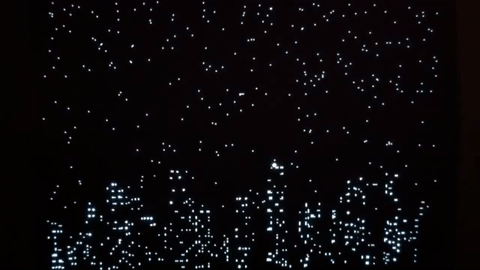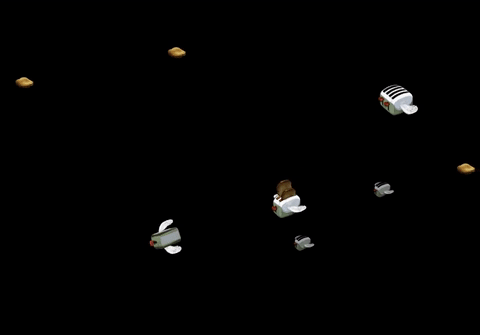Screen Savers
What Were Screen Savers?
How the dreamlike designs let us imagine computers had lives of their own.

Photo illustration by Slate. Photos by Duncan Smith.
At night, the skyline comes into
focus slowly. In the towers, lights blink on one at a time,
indistinguishable at first from the stars above. The outlines of
buildings gradually cohere, some close, some farther away. Everywhere,
shining pinpricks constellate.

This was “Starry Night,” one of the screen savers in a 1989 software package known as After Dark. The collection also included “Flying Toasters,”
a famously kitschy animation of—yes—winged toasters flapping their way
across the monitor’s flat black surface. But where those improbable
aviators feel dated now, “Starry Night” remains almost timeless. One
colleague tells me he remembers watching it when he was growing up in
the Ohio suburbs, trying to form his own idea of what a big city might
be.

I can’t recall the last time I watched a screen saver flicker to
life. That’s largely because we don’t need them anymore, at least not
for the reasons we once did. In the early days of computing, screen
savers were a software solution to a hardware problem. Old cathode ray
tube monitors were vulnerable to a condition known as burn-in, in which
projecting a single image for too long would permanently alter the
screen, imprinting it with a faint phantom double of the thing it had
been forced to linger over. It’s this spectral quality that gave burn-in
its other name, the one I’ve always preferred: ghost images.
The obvious solution was to simply turn off the monitor, and the
first wave of screen savers did little more than automate that process.
Leave the computer undisturbed for a few minutes, and the screen would
shift to black, much as it does when a modern laptop sends itself to
sleep. But as digital artist Rafaël Rozendaal explains,
“Programmers later realized that you could do more interesting things. …
That is when the screensaver changed from a purely functional programme
into a space for play.” Along the way, they became the variegated
static of early personal computing, a subtle thrum at the edge of
perception.
Rozendaal, who orchestrated an exhibition at the Het Nieuwe Instituut in Rotterdam in the Netherlands called Sleep Mode that
takes visitors through the screen saver’s history, suggests these
programs wormed their way into our minds precisely because they allowed
us to abdicate intellectual responsibility. “Most of the things we do on
the computer are done with a purpose in mind, but screensavers relate
to a very different part of your brain,” he says. In this regard, they
represented a respite from the relatively complex, labor-intensive
software of the day. Bill Stewart, one of the progenitors of After Dark,
also theorizes that their relative autonomy was part of their charm.
“Metaphorically, the screensaver was the equivalent of a pet dog who fed
himself, was always ready to play and amuse you, but never bothered you
when you were working,” he says in an interview that accompanies Sleep Mode.
Even when we chose them, personalized them, they were just there—artworks
that we rarely thought of as art, partly because we never knew the
names of the artists who had made them. The best examples of the genre
underscored this sentiment by pushing back against the fact of conscious
human design. Those flying toasters, for example, may have been totally
random (in the idiom of the day), but they were also computationally
random. They never fell into a regimented track, thanks in part to
creator Jack Eastman’s familiarity with Monte Carlo simulations.
Reflecting on the design process in a 2007 interview, he proposed, “I think that was an important idea—we had these little movies, but you couldn’t predict them.”
The seemingly independent vitality of screen savers told a story all
its own, suggesting that our computers were always churning, working,
thinking, even when they weren’t in use. Few captured this frenetic
sentiment better than Windows 95’s “Maze,” a harried, first-person rush
through a brick-walled labyrinth. That endless journey gave the
impression of something like an intelligence at work, albeit an
impoverished one. Watching it flounder was like letting your
grandparents play Wolfenstein 3D while sitting by in
silence as they haplessly mashed the keypad. The longer you spent with
it, the more disquieted you became. Why was the maze mostly empty? Why
did the invisible explorer spin so quickly? What was it running from?
Why was there no exit?

Let Maze run for long enough, and you could only ever conclude that
perpetual motion was the point. As Rozendaal observes, screen savers
served a figurative function: They represented a kind of cognition that
we could appreciate but never quite access. Look closely as pipes filled
the screen, as exotic fish drifted past, as lines of pretend code shot
downward, and you saw something like digital neurons firing. To watch a
screen saver was to cede your own way of being in the world to that of
the computer.
Perhaps screen savers lasted as long as they did precisely because we
dedicated so little thought of our own to them. We could fiddle with
them if we wanted to, but even if we didn’t, they were there by default.
As Tyler Lacoma observes, “Because screensavers were so ubiquitous back in the 1990s and early 2000s, no one questioned their necessity.”
Maybe we should have. Unlike older CRT screens, the liquid crystal
displays that have grown ubiquitous in recent years don’t really suffer
from burn-in. Though they do occasionally run up against problems that look similar,
those issues rarely last for long, the monitor eventually exorcising
its spectral visitors. And yet, Lacoma writes, “By the time that
flat-screened LCD monitors showed up in homes, the idea of a screensaver
was so rooted in the consumer mind that no one ever considered ditching
them.”
They’re still around if you want them, of course. Digging through my
MacBook’s settings, I find 19 options buried within. But there’s a
reason it took me so long to realize they’re part of OSX. By default,
they wait a full 20 minutes before they appear. The system’s “energy
saver” settings, by contrast, put the machine into rest mode after a
mere two minutes of inactivity. There is, in other words, no
circumstance in which I will ever see “Arabesque,” my newly chosen
screen saver, unless I insist on its presence.

It’s possible that even these revenants will vanish soon. Admirers of Microsoft Paint mourned
en masse when the company announced that it would be “deprecating” the
venerable program. But far fewer observers voiced concerns that the same update
would also sideline the screen saver, pushing it aside in deference to
“lockscreen features and policies.” While some of the earliest screen
savers had included password protection options, today security comes
first, far more important than the whimsical creations that once danced
across our monitors.
If the screen saver lives on, though, it likely won’t be in the
interest of preserving such playful visions but because idle screens
represent increasingly valuable swaths of real estate. Think of your
dormant Kindle recommending the latest Jodi Picoult novel or Netflix
autoplaying promotions for its original programming. These companies
have learned to exploit the very thing Rozendaal admires in older screen
savers—the way they snuck into our heads. while we were idle. The weird noise of computing’s past has somehow gathered into commercial signal.
Maybe the change was inevitable. Screen savers were always
disappearing; that was the point. Move your mouse, hit a key, and they
vanish. Though their animations were often hallucinatory, it was that
insubstantial quality that made them truly phantasmagoric. They operated
at the outer limits of attention, engagement, and interaction. Screen
savers belonged to a world we could only ever observe, a world of
dreaming machines.
Leave a Comment